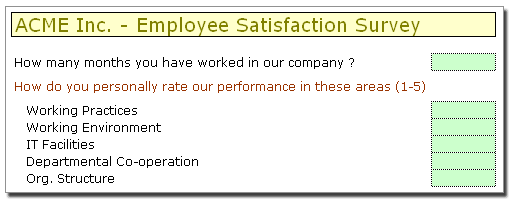Satisfaction Surveys help you measure your employees (or customer) attitude, opinion and satisfaction levels with your product or work place. Unless you are rich, probably you can not afford survey software tools and need a cheap alternative like excel based employee satisfaction surveys.
Today we will learn how to make a satisfaction survey and consolidate the data using excel.

First make your questionnaire in one excel sheet
See the example above.
Now the fun part, send an email to your colleagues with the questionnaire
And go out, get a cup of coffee and learn excel between sips.
Ok, got the replies? well, move on to next step.
Create a new workbook and copy response sheets to this work book
How? Well, there is a simpler way to do. Open each response sheet and right click on the response tab, select “move or copy” and enable copy option and select the new workbook name.

Copied Everything? Time to Learn 3D References
No, don’t fetch your 3D glasses. 3D references are your way to refer to same cell in multiple sheet. Confused ? See this illustration:

So we will use the 3D formula references to compute average satisfaction level for a question like “how cool your company is?”. Assuming the sheets are arranged such that we have Shelly’s sheet first and Zack’s sheet in the end, and the question satisfaction is entered in cell D5, the formula will look like, =average(Shelly:Zack!D5)
Pretty simple, isn’t it?
That is all, you can use the same principles to create customer satisfaction surveys or other types where you need inputs from several parties in same format.
Of course, if you have internet and Google docs access at work, you can use the Google docs forms to do the same with more time to sip that coffee.
This post is part of our spreadcheats series, learn excel articles in this series and findout how you can be more productive.




















4 Responses to “How windy is Wellington? – Using Power Query to gather wind data from web”
Breaking - Wind jokes at Chandoo
Kiwis sniffing for clues about blog post reason
It's confirmed: Wellington is windier than Uranus.
Acompanhando e aguardando ansiosamente a segunda parte.
[]s.
[Google translate]: Accompanying and eagerly awaiting the second part
hi chandoo,
i've tried using power query, however i face a rather weird problem. when i click on 'from web' option, the URL window does not show option for basic and advanced. thus i'm unable to form parameters in URL. how i can resolve this issue?